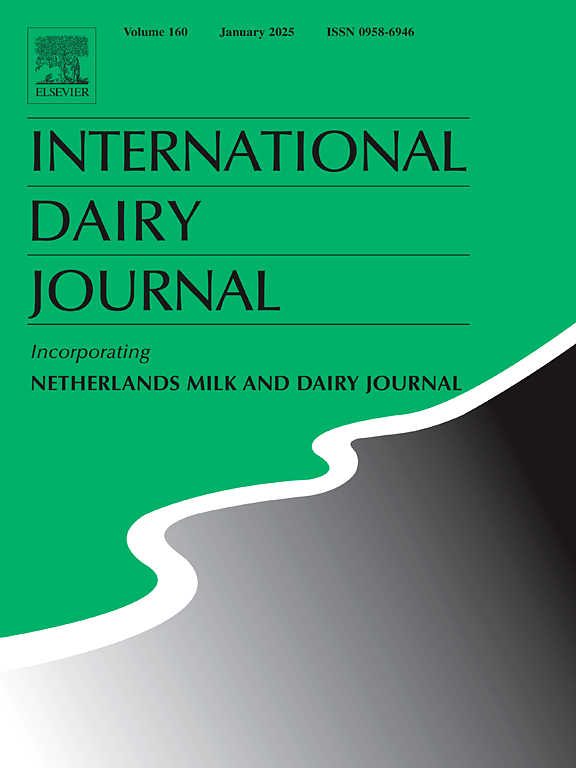高蛋白牦牛奶粉的理化及营养特性
IF 3.1
3区 农林科学
Q2 FOOD SCIENCE & TECHNOLOGY
引用次数: 0
摘要
牦牛奶为高蛋白奶,营养丰富。本研究旨在通过对比分析牦牛奶粉(YM)粉与中老年配方奶粉(S1、S2)的理化特性及营养特性,探讨牦牛奶粉在中老年人群中的应用潜力。YM粉的溶解度(98.27%)高于S1和S2粉,但水分含量、水活度和b∗值均低于S1和S2粉。FTIR结果显示YM具有更有组织的蛋白质二级结构。与S1和S2粉相比,YM粉的蛋白质含量较高,尤其是乳铁蛋白(0.76 g/100 g)和免疫球蛋白g (0.27 g/100 g)。YM粉中氨基酸分布均衡,必需氨基酸含量高(15.2 g/100 g),必需氨基酸指数接近优质蛋白质参考值,是理想的蛋白质来源。此外,YM粉中Ca、Mg、VC和VE含量最高。短链和中链脂肪酸以及必需脂肪酸也占主导地位。综上所述,牦牛奶粉具有稳定的理化性质和独特的营养成分,适合作为中老年人群的天然营养补充。本文章由计算机程序翻译,如有差异,请以英文原文为准。
The physicochemical and nutritional profile of high protein yak milk powder
Yak milk for a high-milk protein that is rich in nutrition. The objective of this study was to assess the potential application of yak milk powder in the middle-aged and elderly through a comparative analysis of the physical and chemical properties as well as nutritional characteristics of yak milk (YM) powder with those of middle-aged and elderly formula milk powders (S1 and S2). YM powder exhibited higher solubility (98.27%) than S1 and S2 powder, whereas the moisture content, water activity and b∗ value were lower. The FTIR results revealed that YM displayed a more organized protein secondary structure. In comparison to S1 and S2 powder, YM powder contained higher levels of protein, particularly lactoferrin (0.76 g/100 g) and immunoglobulin G (0.27 g/100 g). The amino acid distribution in YM powder was well-balanced, featuring a high content of essential amino acids (15.2 g/100 g) and an essential amino acid index close to the reference value for high-quality proteins, thus making it an ideal protein source. Additionally, YM powder exhibited the highest of Ca, Mg, VC, and VE. It also had dominant levels of short and medium-chain fatty acids as well as essential fatty acids. In conclusion, our findings demonstrate that yak milk powder possesses stable physicochemical properties and a unique nutritional composition, indicating its suitability for natural nutritional supplementation in middle-aged and elderly individuals.
求助全文
通过发布文献求助,成功后即可免费获取论文全文。
去求助
来源期刊

International Dairy Journal
工程技术-食品科技
CiteScore
6.50
自引率
9.70%
发文量
200
审稿时长
49 days
期刊介绍:
The International Dairy Journal publishes significant advancements in dairy science and technology in the form of research articles and critical reviews that are of relevance to the broader international dairy community. Within this scope, research on the science and technology of milk and dairy products and the nutritional and health aspects of dairy foods are included; the journal pays particular attention to applied research and its interface with the dairy industry.
The journal''s coverage includes the following, where directly applicable to dairy science and technology:
• Chemistry and physico-chemical properties of milk constituents
• Microbiology, food safety, enzymology, biotechnology
• Processing and engineering
• Emulsion science, food structure, and texture
• Raw material quality and effect on relevant products
• Flavour and off-flavour development
• Technological functionality and applications of dairy ingredients
• Sensory and consumer sciences
• Nutrition and substantiation of human health implications of milk components or dairy products
International Dairy Journal does not publish papers related to milk production, animal health and other aspects of on-farm milk production unless there is a clear relationship to dairy technology, human health or final product quality.
 求助内容:
求助内容: 应助结果提醒方式:
应助结果提醒方式:


